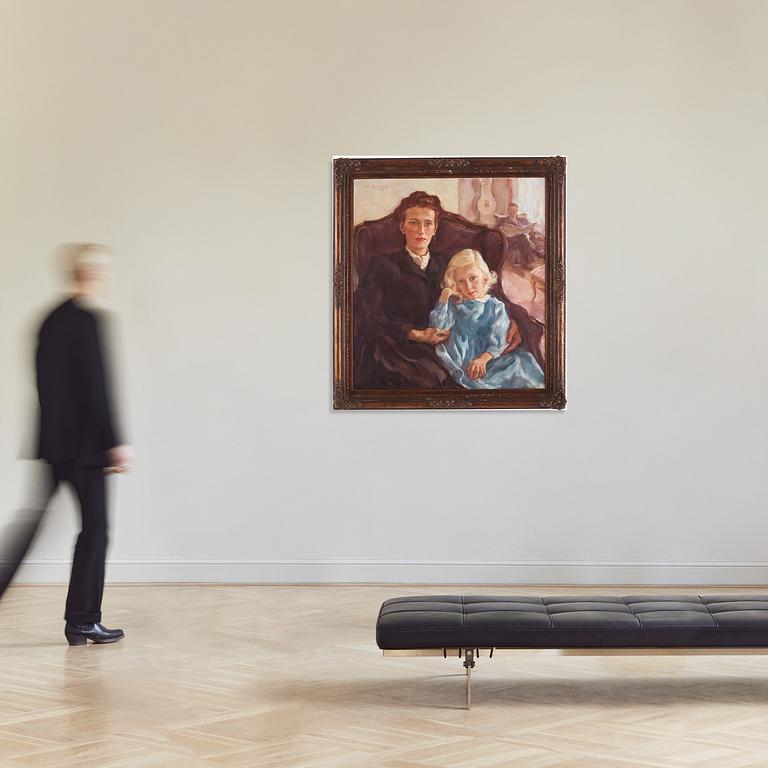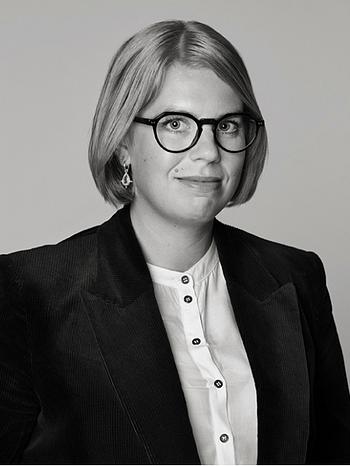Lotte Laserstein
Portrait of the Cedergren family (Jan, Ingeborg, and Madeleine)
Signed Lotte Laserstein and dated 1949. Canvas 100.5 x 91 cm.
Provenance
Acquired directly from the artist, then inherited by the current owner.
More information
Lotte Laserstein (1898-1993) was born in East Germany; her father died in 1902 and she was raised by her mother and grandmother in what is now Gdansk and Berlin. In 1927 she graduated from the Academy of Fine Arts in Berlin, one of the first female students, and was immediately successful. She quickly became known on the city's art scene for her skilled portrait painting, especially of young modern women of the 1920s. When the Nazis came and took power in 1933, her promising career was cut short when, in accordance with the ideology of the time, she was categorised as 3/4 Jewish (her grandparents were Jewish but her own parents were not). As a result, she was increasingly excluded from the art scene.
However, an invitation to exhibit at Galerie Moderne in Stockholm in 1937 opened up an opportunity for her to leave her home country. She travelled from Berlin in 1937 and managed to ship the majority of her works to Stockholm. The exhibition took place and she was able to remain in Sweden on a three-month visa. In Stockholm, she made new friends, some of whom helped her to enter into a fake marriage, allowing her to obtain Swedish citizenship.
Laserstein tried to build a new life in Stockholm, making a living mainly by commissioning portraits. She found it difficult to enter new art circles, where modernism and abstract painting were emphasised. She applied for membership in the Artists' National Organisation (KRO), but was refused on several occasions, which was a personal defeat. She was not considered sufficiently modern, and her consistent adherence to realism during the dominance of artistic abstraction in the post-war decades probably contributed to her lack of a major breakthrough in Sweden.
Laserstein received a classical academic education and her work often contains references to art history. But in her artistically expansive phase during the 1920s and 1930s, she also drew on contemporary popular culture in her motifs. She was influenced by the liberating fashions for women at the time: wearing loose-fitting dresses, cutting her hair short, dressing and emphasising androgynous features. Laserstein liked to depict modern empowered women playing sports or sitting alone in a café. Her art is categorised as 'new objectivity' and is at once traditionally figurative and discreetly rebellious. People were Laserstein's main subject and she painted around 2000 portraits during her life. She was able to make a living from art throughout her life, and her clients included well-known personalities from the aristocracy as well as from politics, business and culture.
In 1952, Lotte Laserstein was commissioned to portray the then governor of Kalmar, Ruben and Helga Wagnsson. In connection with this, she began commuting between Kalmar and Stockholm. She took a liking to Öland, where she bought a summer cottage in the early 1950s. In 1957 she settled permanently in Kalmar. Laserstein continued to paint portraits but also devoted herself to floral still lifes and landscapes. At exhibitions in Kalmar she exhibited new oils, drawings, watercolours and pastels. Her studio and home were located on Norra Långgatan in Kalmar, where her central works from the Berlin period were hung.
In 1987, Laserstein's paintings came to the attention of two prestigious galleries in London, marking the beginning of an international rediscovery. In 2003 she was also recognised in Germany with an exhibition at the Museum Ephraim-Palais in Berlin. Anna-Carola Krausse, who also wrote her doctoral thesis on Lotte Laserstein and a presentation of her life and work, was responsible for the German exhibition and its catalogue. "Meine einzige Wirklichkeit" was the theme of the Berlin exhibition, a quote from Lotte Laserstein who saw art as the reality she lived in and for. In Sweden, her work was first highlighted in a memorial exhibition at Kalmar Museum in 2004, then at the Jewish Museum and later at Bror Hjorth's house in Uppsala.
The auction's delicate family portrait depicts the Cedergren family, mother Ingeborg with daughter Madeleine in her arms in the foreground and father Jan in the background reading the newspaper. The structure of the painting creates several dimensions and focal points for the viewer and the portrait appears to be anything but a normal family portrait.












































